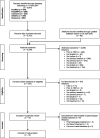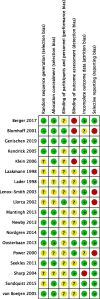Contemporary treatment of anxiety in primary care: a systematic review and meta-analysis of outcomes in countries with universal healthcare
- PMID: 33992082
- PMCID: PMC8126070
- DOI: 10.1186/s12875-021-01445-5
Contemporary treatment of anxiety in primary care: a systematic review and meta-analysis of outcomes in countries with universal healthcare
Abstract
Background: Anxiety disorders are highly prevalent mental health conditions and are managed predominantly in primary care. We conducted a systematic review and meta-analysis of psychological and pharmacological treatments in countries with universal healthcare, and investigated the influence of treatment provider on the efficacy of psychological treatment.
Method: PubMed, Cochrane, PsycINFO, CINAHL, and Scopus were searched in April 2017 for controlled studies of evidence-based anxiety treatment in adults in primary care, published in English since 1997. Searches were repeated in April 2020. We synthesised results using a combination of meta-analysis and narrative methods. Meta-analysis was conducted using a random-effects multi-level model to account for intercorrelation between effects contributed different treatment arms of the same study. Moderator variables were explored using meta-regression analyses.
Results: In total, 19 articles (from an initial 2,247) reporting 18 studies were included. Meta-analysis including ten studies (n = 1,308) found a pooled effect size of g = 1.16 (95%CI = 0.63 - 1.69) for psychological treatment compared to waitlist control, and no significant effect compared to care as usual (p = .225). Substantial heterogeneity was present (I2 = 81.25). Specialist treatment produced large effects compared to both waitlist control (g = 1.46, 95%CI = 0.96 - 1.96) and care as usual (g = 0.76, 95%CI = 0.27 - 1.25). Treatment provided by non-specialists was only superior to waitlist control (g = 0.80, 95%CI = 0.31 - 1.28). We identified relatively few studies (n = 4) of medications, which reported small to moderate effects for SSRI/SNRI medications and hydroxyzine. The quality of included studies was variable and most studies had at least "unclear" risk of bias in one or more key domains.
Conclusions: Psychological treatments for anxiety are effective in primary care and are more effective when provided by a specialist (psychologist or clinical psychologist) than a non-specialist (GP, nurse, trainee). However, non-specialists provide effective treatment compared with no care at all. Limited research into the efficacy of pharmacological treatments in primary care needs to be considered carefully by prescribers TRIAL REGISTRATION: PROSPERO registration number CRD42018050659.
Keywords: Anxiety; Meta-analysis; Pharmacological treatment; Primary care; Psychological treatment; Systematic review.
Conflict of interest statement
ELP is paid by Marathon Health for provision of psychological therapy services and runs a private practice as a psychologist. No other relationships or activities with potential to bias the work are identified.
Figures




Similar articles
-
Psychological interventions for improving adherence to inhaled therapies in people with cystic fibrosis.Cochrane Database Syst Rev. 2023 Mar 29;3(3):CD013766. doi: 10.1002/14651858.CD013766.pub2. Cochrane Database Syst Rev. 2023. PMID: 36989170 Free PMC article. Review.
-
Behavioural modification interventions for medically unexplained symptoms in primary care: systematic reviews and economic evaluation.Health Technol Assess. 2020 Sep;24(46):1-490. doi: 10.3310/hta24460. Health Technol Assess. 2020. PMID: 32975190 Free PMC article.
-
Telephone interventions for symptom management in adults with cancer.Cochrane Database Syst Rev. 2020 Jun 2;6(6):CD007568. doi: 10.1002/14651858.CD007568.pub2. Cochrane Database Syst Rev. 2020. PMID: 32483832 Free PMC article.
-
Interventions for adults with a history of complex traumatic events: the INCiTE mixed-methods systematic review.Health Technol Assess. 2020 Sep;24(43):1-312. doi: 10.3310/hta24430. Health Technol Assess. 2020. PMID: 32924926 Free PMC article.
-
Deployment of personnel to military operations: impact on mental health and social functioning.Campbell Syst Rev. 2018 Jun 1;14(1):1-127. doi: 10.4073/csr.2018.6. eCollection 2018. Campbell Syst Rev. 2018. PMID: 37131363 Free PMC article.
Cited by
-
Consumption patterns and factors associated with inappropriate prescribing of benzodiazepines in Primary Health Care settings.PLoS One. 2024 Sep 4;19(9):e0309984. doi: 10.1371/journal.pone.0309984. eCollection 2024. PLoS One. 2024. PMID: 39231170 Free PMC article.
-
Changes in anxiety in the general population over a six-year period.PLoS One. 2023 Sep 12;18(9):e0291206. doi: 10.1371/journal.pone.0291206. eCollection 2023. PLoS One. 2023. PMID: 37699040 Free PMC article.
-
Australian Mental Health Consumers' Experiences of Service Engagement and Disengagement: A Descriptive Study.Int J Environ Res Public Health. 2021 Oct 5;18(19):10464. doi: 10.3390/ijerph181910464. Int J Environ Res Public Health. 2021. PMID: 34639765 Free PMC article.
-
Personalized online intervention based on a risk algorithm for the universal prevention of anxiety disorders: Design and development of the prevANS intervention.Digit Health. 2024 Oct 25;10:20552076241292418. doi: 10.1177/20552076241292418. eCollection 2024 Jan-Dec. Digit Health. 2024. PMID: 39493626 Free PMC article.
-
Effectiveness of mHealth interventions targeting physical activity, sedentary behaviour, sleep or nutrition on emotional, behavioural and eating disorders in adolescents: a systematic review and meta-analysis.Front Digit Health. 2025 Jul 21;7:1593677. doi: 10.3389/fdgth.2025.1593677. eCollection 2025. Front Digit Health. 2025. PMID: 40761810 Free PMC article.
References
Publication types
MeSH terms
LinkOut - more resources
Full Text Sources
Other Literature Sources
Medical
Miscellaneous

